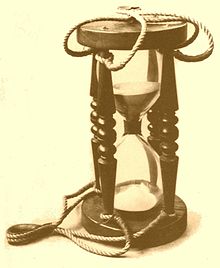
A marine sandglass is a timepiece of simple design that is a relative of the common hourglass, a marine (nautical) instrument known since the 14th century (although reasonably presumed to be of very ancient use and origin). Sandglasses were used to measure the time at sea or on a given navigational course, in repeated measures of small time increments (e.g., 30 minutes). Used together with the chip log, smaller marine sandglasses were also used to measure the boat speed through the water in knots.
Although vital to maritime navigation, marine sandglasses were not accurate measuring instruments for the passage of time; many design and environmental factors could affect the duration of sand's flow, and therefore its reported time. Their use continued through the early 19th century, when they were supplanted by reliable mechanical timepieces and by other advances in marine navigation.
Marine sandglasses were very popular on ships, as they were the most dependable measurement of time while at sea. Unlike the liquid-based clepsydra, the motion of the ship did not affect the hourglass. The fact that the hourglass also used granular materials instead of liquids gave it more accurate measurements, as the clepsydra was prone to get condensation inside it during temperature changes.[1] In conjunction with a record of a ship's speed and direction, seamen used the hourglass to determine their position with reasonable accuracy.[1]